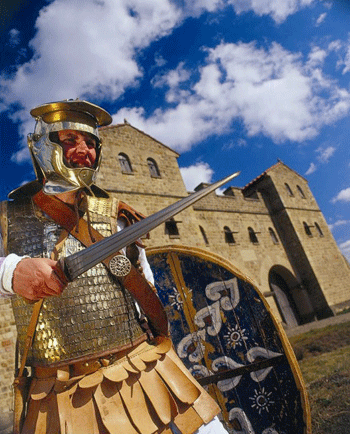Bede's Bible to take centre stage as treasures return to north-east birthplace
 Some of England’s most precious historical and religious treasures are to return to their North East birthplace as part of a major project highlighting the region’s heritage and identity.
Some of England’s most precious historical and religious treasures are to return to their North East birthplace as part of a major project highlighting the region’s heritage and identity.
Throughout the Middle Ages South Tyneside was at the heart, not only of English Christianity, but of learning and culture.
Now, some of its greatest achievements – from Bede’s Great Bible to the Boldon Book – are to go on display in the borough as part of a three-year Treasures programme.
On Sunday 18 May, Bede’s World, Jarrow, will unveil a full-sized replica of the Codex Amiatinus – the lost masterpiece of the Wearmouth-Jarrow monastery Scriptorium, where Bede was a monk. The Scriptorium was famous for the quality of its writing and this massive bible has 2060 pages of script and illustrations.
The replica was handmade for San Salvatore monastery in Italy, home to the actual Codex Amiatinus for more than 1000 years, and this is the first time the replica has travelled outside Italy.
Meanwhile, from 19 July, Bede’s World will also host Banners of the North – an array of treasures, on loan from the British Museum, which highlight the forming of a new, northern identity following the invasion of William the Conqueror.
Among them are a 15th century gold signet ring, believed to have belonged to the Percy family during the Wars of the Roses and a gold pendant depicting St George slaying the dragon.
The Treasures programme will also include a copy of the Boldon Book manuscript of 1183. Set to go on display at South Shields Museum and Art Gallery from 19 July, the earliest surviving copy of the 12th century Boldon Book is a special loan from the British Library.
The manuscript features some of the earliest references and information about villages in the borough including Boldon, after which the book is named.
In addition, Arbeia Roman Fort, South Shields, will welcome The Glory of Rome: Arbeia’s Greatest Treasures from 17 July, allowing visitors to see some of the greatest Roman artefacts in Britain, discovered in and around the fort.
Highlights of the exhibition include the spectacular Shield Boss, on loan from the British Museum, found near the mouth of the River Tyne in 1866 and dating back to the early second century AD. Also on display will be both the Regina and Victor tombstones, considered to be two of the finest pieces of sculpture from Roman Britain.
“Each item in the Treasures programme has been chosen because of its links to this region,” said Bede ward Councillor Fay Cunningham at South Tyneside Council, “and it makes you very aware of what a crucial role we have played in all aspects of cultural and religious development throughout the ages.
“It is an incredible undertaking to bring all these treasures together for the very first time and we are very grateful to all those – such as the British Museum – who have made it possible.”


 Votes : 0
Votes : 0









